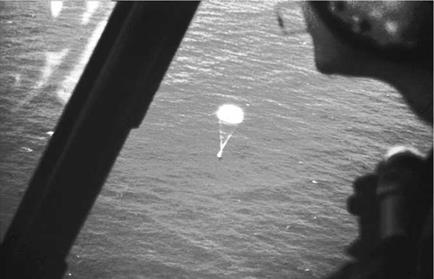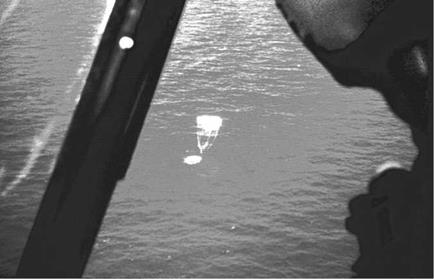A HERO RETURNS
At last, and for the first time in history, a spacecraft had completely returned to Earth from space with a human being on board. Even Yuri Gagarin and his Soviet space masters could not match this technological feat – although several years would pass before the truth was finally revealed – as the first cosmonaut had been ejected from his descending Vostok capsule to parachute to the ground according to highly secret plans. A workable and reliable retrorocket system had yet to be developed by Soviet engineers that would allow a controlled, soft landing for returning cosmonauts. As a result, all six Vostok pilots were required to eject from their vehicles. One reason for keeping this secret was that the Federation Aeronautique Internationale, which rules on aviation records, requires that a pilot be in his aircraft at the time of landing.
Arthur Cohen, who headed the IBM team that created and ran the computers that modeled and then tracked the flight, would report, “Everything went smoothly. All the plotting was perfect. Everything on the flight was nominal. There was really no problem whatsoever. It landed at exactly the right place.” [10]
|
Freedom 7 photographed moments before it splashed down in the Atlantic. (Photo courtesy of Ed Killian) |
|
The capsule hits the water, concluding America’s first manned space mission. (Photo courtesy of Ed Killian) |
For his part, Shepard was exuberant over his safe return. “Splashdown!” he later wrote of that moment. “Into the water we went with a good pop! Abrupt, but not bad. No worse than the kick in the butt when I was catapulted off a carrier deck. This was home plate!” [11]
Prior to impacting the water, he had removed his knee straps. He now began his post-splashdown procedures. The first thing was to release his face plate seal bottle. This was a small pressure bottle joined by a thin hose to a connector next to his left jaw. It was used to pressurize a pneumatic seal when the face plate was closed. He then removed the exhaust hose from the helmet.
Once Freedom 7 had splashed down, it quickly swayed over on its side, about 60 degrees from vertical, covering the right porthole with seawater and causing Shepard to lean over onto his right side in the couch. Seeing that the porthole’s exterior was completely under water, he deduced that everything was going to plan. Through the other porthole he could also make out the bright green fluorescing dye automatically spreading out through the water to mark his position for recovery aircraft.
“As I waited for the shifted balance to right my great spacecraft – but lousy boat – I kept thinking about the chimp’s near-disappearance beneath the ocean. I checked and checked the cabin for leaks, ready to punch out. But I stayed dry.”
Shepard then activated the ‘rescue aids’ switch to jettison the reserve parachute, thereby reducing some of the top-heavy weight of the spacecraft and allowing it to stabilize itself upright in the water. “Shifting the center of gravity had worked, and the capsule came back upright.” [12] Flipping the switch also released the HF antenna, although he did leave his transmit switch in the UHF position. To his relief, all of the recovery aids seemed to be working well, although he was not to know that the HF antenna had failed to extend skywards. However, with the recovery ships and aircraft in the immediate vicinity its function as a location device was not needed.
“I’d broken my helmet at the neck ring seal at this point, and I did no transmitting here,” he later observed in his initial flight report aboard the recovery carrier. “I left the switch on R/T [receive/transmit] because I didn’t want any discharge from the UHF antenna [13].
“I could not see any water seeping into the capsule, but I could hear all kinds of gurgling sounds around me, so I wasn’t sure whether we were leaking. I remember reassuring myself that I had practiced getting out of the capsule under water and that I could do it now if I had to. But I didn’t have to try. Slowly, but steadily, the capsule began to right itself.” [14]
It was time to assure everyone he had survived the splashdown by making contact with the communications relay airplane (codename Cardfile Two Three) which was circling overhead.
“Cardfile Two Three” he called. “This is Freedom 7. Would you please relay: All is okay.”
“This is Two Three” came the reply. “Roger that.”
“This is Seven. Dye marker is out. Everything is okay. Ready for recovery.”
“Seven, this is Two Three. Rescue One will be at your location momentarily.”
Shepard continued his preparations to leave Freedom 7 as the spacecraft became almost vertical in the water. He began to document the instruments prior to shutting down the power. “I had just started to make a final reading on all of the instruments when the helicopter pilot called me. I had already told him that I was in good shape, but he seemed in a hurry to get me out. I heard the shepherd’s hook catch hold of the top of the capsule, and then the pilot called again.” [15]












